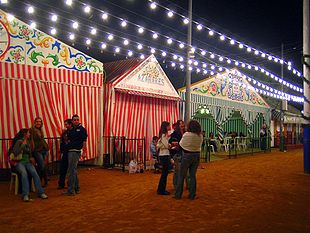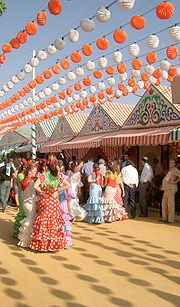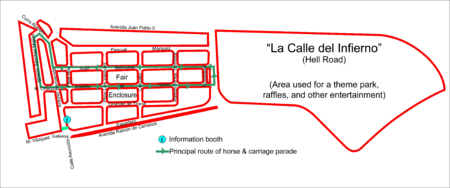
Seville Fair
Encyclopedia

Andalusia
Andalusia is the most populous and the second largest in area of the autonomous communities of Spain. The Andalusian autonomous community is officially recognised as a nationality of Spain. The territory is divided into eight provinces: Huelva, Seville, Cádiz, Córdoba, Málaga, Jaén, Granada and...
n capital of Seville
Seville
Seville is the artistic, historic, cultural, and financial capital of southern Spain. It is the capital of the autonomous community of Andalusia and of the province of Seville. It is situated on the plain of the River Guadalquivir, with an average elevation of above sea level...
, Spain
Spain
Spain , officially the Kingdom of Spain languages]] under the European Charter for Regional or Minority Languages. In each of these, Spain's official name is as follows:;;;;;;), is a country and member state of the European Union located in southwestern Europe on the Iberian Peninsula...
. The fair generally begins two weeks after the Semana Santa, or Easter
Easter
Easter is the central feast in the Christian liturgical year. According to the Canonical gospels, Jesus rose from the dead on the third day after his crucifixion. His resurrection is celebrated on Easter Day or Easter Sunday...
Holy Week.
The fair officially begins at midnight on Monday, and runs six days, ending on the following Sunday. During past fairs, however, many activities have begun on the Saturday prior to the official opening. Each day the fiesta
Festival
A festival or gala is an event, usually and ordinarily staged by a local community, which centers on and celebrates some unique aspect of that community and the Festival....
begins with the parade
Parade
A parade is a procession of people, usually organized along a street, often in costume, and often accompanied by marching bands, floats or sometimes large balloons. Parades are held for a wide range of reasons, but are usually celebrations of some kind...
of carriages and riders, at midday, carrying Seville's leading citizens which make their way to the bullring, La Real Maestranza, where the bullfighters and breeders meet.
For the duration of the fair, the fairgrounds and a vast area on the far bank of the Guadalquivir River are totally covered in rows of casetas (individual decorated marquee tents which are temporarily built on the fairground). Some of these casetas belong to the prominent families of Seville, some to groups of friends, clubs, trade associations or political parties. From around nine at night until six or seven the following morning, at first in the streets and later only within each caseta, you will find crowds partying and dancing "Sevillanas
Sevillanas
Sevillanas are a type of folk music, sung and written in Seville in Spain. Historically, they are a derivative of Castilian folk music . They have a relatively limited musical pattern, but rich lyrics, based on country side life, virgins, towns, neighborhoods, pilgrimage, and love themes...
", drinking Jerez sherry, or manzanilla wine, and eating tapas
Tapas
Tapas are a wide variety of appetizers, or snacks, in Spanish cuisine. They may be cold or warm ....
.
History
The Fair dates back to 1847 when it was originally organized as a livestock fair by two councillors born in Northern Spain, Basque José María Ybarra and Catalonian Narciso Bonaplata. Queen Isabel IIIsabella II of Spain
Isabella II was the only female monarch of Spain in modern times. She came to the throne as an infant, but her succession was disputed by the Carlists, who refused to recognise a female sovereign, leading to the Carlist Wars. After a troubled reign, she was deposed in the Glorious Revolution of...
agreed to the proposal, and on 18 April 1847 the first fair was held at the Prado de San Sebastian, on the outskirts of the city.
It took only one year before an air of festivity began to transform the fair, due mainly to the emergence of the first three casetas, belonging to the Duke and Duchess of Montpensier
Montpensier
The French lordship of Montpensier , located in historical Auvergne, became a countship in the 14th century....
, the Town Hall, and the Casino of Seville. During the 1920s, the fair reached its peak and became the spectacle that it is today.
Costumes

Flamenco
Flamenco is a genre of music and dance which has its foundation in Andalusian music and dance and in whose evolution Andalusian Gypsies played an important part....
) for women. The men traditionally wear hats called "cordobés".


